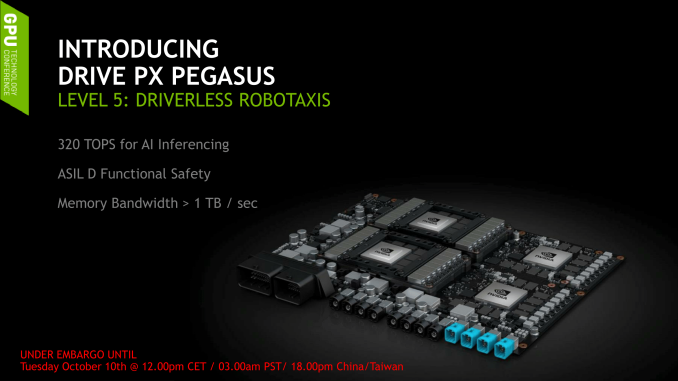Volta already improved the compute capabilities a lot. I don't think they will change it a lot before voltas 7nm successor. That's why i believe in TCs with lower accuracy. This should be easy to do, without too much effort.
We already know, that a GPU with more TC Flops than V100 is sampling in Q2:
https://www.anandtech.com/show/1191...-pegasus-at-gtc-europe-2017-feat-nextgen-gpus
Xavier is 2x30 Tops, this leaves 2 x 130 TOPS for the 2 gpus. Nvidia mentioned the gpus on pegasus are post-volta architecture. So either Nvidia pushed many tensor cores in their gaming architecture and they changed the name to Turing, because of the company Ampere. Or we have a gaming architecture and a AI architecture. But if Turing is a new AI architecture, why don't they put it into Xavier? There are many open questions. It seems V100s 150W TDP version for inference is not coming anymore.
Yes and No depends upon what your perspective is.
It improved it a bit relative to what one expects as an evolution from Pascal and when considering AMD's capabilities, the mixed-precision compute/concurrency-simultaneous operations can be evolved a lot more from what was done with Pascal.
Tensor has no benefit for gaming, improved compute and concurrent-simultaneous operations can.
Volta V100 does 120 TOPs, so the double dGPU each with 130 TOPS on Pegasus is an expected improvement relating to that model design.
I mentioned the V100 150W because that is closer to what one would expect from a Tensor product, and if it can do FP16 inferencing it can do training as well.....
There will be a push for mixed-precision requirements (without DP) in gaming down the line, and Nvidia needs to incorporate that into Geforce at some point, but in a way that aligns with the evolution of what they did with Pascal-Volta and would provide synergy with other Tesla and Quadro GPUs beyond the flagship mixed-precision (with DP).
Remember Volta and all its Nvidia presentations going back years talk about it within a very specific HPC framework and not from a Tesla broad product line that is say from GP104 to GP100 (flagship HPC mixed-precision) when looking at Pascal, which one also then needs to consider Quadro and that segment including on top of the traditional range Nvidia is also looking to also push mixed-precision with the Quadro GP100.
Anyway to reiterate Nvidia still has quite a lot of room to evolve their compute capabilities and operations from a CUDA core-register perspective, including the mixed-precision and simultaneous operations.
Do not forget that a
complete product line will take over 12 months to come to market; meaning any product design is not just short term but a strategy to last quite awhile covering a broad range of segments and models.
Pascal had an accelerated product release but it aligned with the need to do the P100 followed by the V100 for large obligated HPC contracts in late 2017; it changed the strategy completely on how to launch products and they started with the highest risk/cost/yield issue 610mm2 die Pascal (or 815mm2 Volta) and worked their way down rather than working their way up as in the past.

